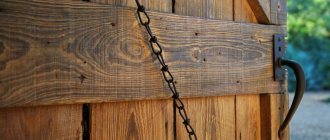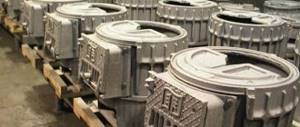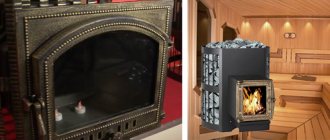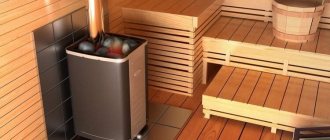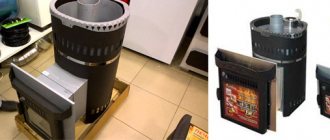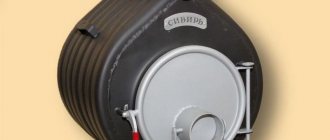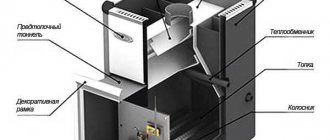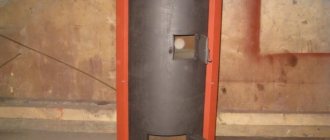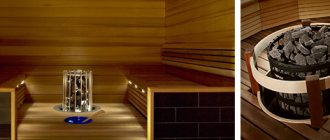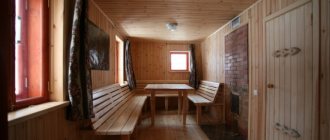Interest in choosing a budget fireplace stove, against the backdrop of the crisis in the country, is only growing day by day. In this case, a fireplace stove is selected for a house measuring 8x4 m; the construction of the house itself took a lot of time, and now it’s time to choose a stove. Funds are limited, so the choice will only be budgetary, however, there is still a choice option, and you want to choose the best option. The choice was not wide at all. For a room slightly less than 100 m3, there is not much choice on the market in the budget line. So in the end I chose between fireplace stoves. The choice as a result was made between the Vesuvius PK-01 and Brandenburg furnaces. Vesuvius seemed more interesting in appearance because of the doors and its dimensions were more compact. So the choice was made - the stove was delivered and installed. Everything arrived safe and sound. The chimney was chosen from the Vulcan brand. After watching the training video, the chimney was assembled by the house owner himself.
After flooding on the first day, the paint smoked, but the house became warm immediately. It's about 0 or a little colder outside. The doors and one window were wide open. At the same time it was warm. The next day in the morning the stove was flooded again. Unfortunately, it happened that one tile burst. It's a shame, but this happens from time to time. There are also very expensive tiles that constantly break. I had no experience in firing a furnace. The duration of the firebox at the first loading (5 logs of euro firewood, with a hole) burned out in three hours (with the vent and damper closed). As a result, with such fuel the stove gave off heat intensively. On the second day, the tiles burst, the fire began to happen little by little, experimenting with different modes. For an area of 30 m2, a fireplace stove is quite suitable. In order to get used to the stove, in any case, you need to get used to it, study it, and then the firebox will go on easily and naturally.
Features of Vesuvius stoves
Vesuvius models are distinguished by the complete absence of sharp corners. The design of the stove has a round shape, which allows thermal radiation to be evenly distributed throughout the room, warming the air to the specified temperatures. The outer casing of the unit is made of all-welded steel plates. The metal thickness is 8 mm. The plates are secured with bolts. Fastening provides increased strength of products.
Thanks to the outer mesh, the stones in the oven are heated evenly. They dampen the infrared radiation of hot metal. The disadvantage of the outer mesh is dry steam. You won't be able to get a light, damp cloud without additional devices. For lovers of Russian steam rooms, it is better to give preference to models with a closed heater. Full use of an open-type heater in a Russian bath requires the additional installation of a steam generator.
The body of the Vesuvius furnace is coated with a protective silicone compound. The coating protects it from exposure to high temperatures and humidity. Some models are decorated with forged parts. Typical for models with a fireplace function. If necessary, you can hide the equipment behind a brick screen; models without complex decor are purchased.
All Vesuvius models have a standard chimney diameter of 115 mm and a combustion tunnel depth of 290 mm. This is convenient when replacing components.
The warranty period for cast iron models is 35 years.
Bath stove Vesuvius Legend
The Vesuvius Legend stove model is constructed of 3 cast iron parts. The thickness of the material is 12 mm. The joints of the fragments are sealed with ceramic cord. The operating temperature that the cord can withstand is 1200 degrees. This is enough for a sauna stove. All parts are secured with bolts. The pipe from the chimney firebox is separated by a bumper. The design allows for rotation of the flame in the firebox. This increases the efficiency of heating equipment four times. Cast iron maintains a high temperature in the steam room for a long time.
The stone net is installed outside. When heated, the stones provide uniform heat and shield the radiation from the firebox. The large mass of stones provides light steam. The humidity of the vapor cloud depends on the heating temperature and the amount of water in the tank. You can add water to the stones from above. In this case, the steam will turn out heavy and watery. The steam room warms up within an hour.
In the “Legend” series, the manufacturer produces models of stoves with forged elements.
The manufacturer provides a 30-year guarantee for the Vesuvius Legend model. The model from the “Forging” series has an external firebox. The element makes it possible to heat the steam room from the adjacent room.
Furnace Vesuvius Skif
The Vesuvius Skif model series is a budget line of the manufacturer. They are made from engineered steel. The thickness of the sheets is 12 mm. This type of steel lasts a long time. The walls do not bend outward or become deformed. The stove is made using Finnish technology. The joints are laid with heat-resistant cord. The part can withstand temperatures up to 1200 degrees. The parts are connected to each other with bolts. The firebox is remote. The steam room is heated from the adjacent room.
The stone net is installed outside. The steam turns out to be dispersed. Due to the design of the stove, it is suitable for a Finnish steam room. For a classic Russian steam room, the unit does not have enough humidity. This is compensated by the additional installation of a steam generator or pipe system. The volume of the steam room for the standard model ranges from 8 to 18 square meters.
The advantage of the Skif stove is considered to be its price. It is cheaper than a cast iron product. Warranty period 2.5 – 3 years.
Vesuvius 16
“Vesuvius” 16 – closed heater. Consists of three elements: body, firebox, pipe. The parts are secured with a bolted connection. It increases the strength of the structure. A ceramic cord is laid at the joints. The operating temperature of the wire is 1200 degrees.
The model is equipped with a sealed door made of cast iron. The design includes heat-resistant glass. The body is made of steel. The ventilated oven casing is made of textured metal sheets. They are coated with heat-resistant bronze-colored paint. The stove is heated from the room adjacent to the steam room. For this purpose it is equipped with a combustion tunnel.
Vesuvius 16 will warm up a steam room up to 18 cubic meters in size in 50 minutes. The heat-resistant glass built into the door allows you to observe the burning of firewood in the stove.
Characteristics of the Legend Lux model
This Vesuvius stove is suitable for steam rooms with an area of about 12 square meters. meters. The convector in the device is installed on the lower frame. The oven is easy to use. The ash pan for this purpose is of a pull-out type. The external tunnel is 2.2 cm in diameter. The immediate rear wall is not wide. The grate in the design is located next to the convector.
The cut-off valve in the oven has three holes. The afterburner is large, so heating is quick. In this case, steam can be easily obtained using a dispenser. The model has a blower with a vault. The ceiling on the frame is made of steel and is not subject to deformation. On the market, this stove will cost the buyer about 42 thousand rubles.
Installation of the Vesuvius furnace
Installing a stove is the most important undertaking. The equipment interacts with flammable materials indoors. Fire safety standards must be strictly observed during installation. But before describing the installation process, a few words should be said about choosing a model.
The market offers the installation of metal heaters in bathhouses and stone ones. Metal models benefit from their practicality and safety. The choice of model depends on factors:
- volume of the steam room;
- type of thermal insulation;
- area of the entire bath;
- desired temperature and humidity levels in the steam room;
- heating time.
Attention!
If you decide to install the device yourself, you need to carefully read the manufacturer’s instructions. It indicates the installation features of a specific model. The first step is to prepare the floor. The furnace installation area is covered with a metal sheet, or brickwork is installed. Indentations are made by 15-20 centimeters on all sides. The top is covered with a steel sheet or a cement screed is poured.
The oven is installed on the surface, observing the indentations. They are specified in the installation instructions for a specific model.
Important! The distance from the stove to the ceiling is 120 centimeters, from the heating device to the partitions is at least 32 cm.
It is possible to reduce the distance by several centimeters if there is additional protection in the form of a metal sheet.
When installing the stove, you should take into account the direction of the heating chamber. Models may involve loading fuel from adjacent rooms. This condition complicates installation, but provides more advantages when operating the furnace.
The next step is the installation of a mounted tank. It is installed in an adjacent room, or, in accordance with the instructions, for a specific stove model.
The heat exchange system consists of the following parts:
- heat exchanger;
- fittings;
- remote tank;
- connection elements.
When installing a heat exchange system, you should not use flexible plastic or rubber liners. In order to avoid freezing of water in the system in winter, a drain valve is built into the lower part of the fitting.
The last step is to install the pipe. It must be at least 5 meters. It is worth paying attention to the chimney pipe. It is made from fire-resistant materials. The height of the pipe must exceed the roof level of the nearest houses.
Start the oven only after thoroughly checking all connections and fasteners. During the first heating, an unpleasant smell of burning and chemical industry products may be felt. These are burning oils that got into the unit during the manufacturing process. It should be heated for an hour. During this time, the tank, heat exchange system and other parts of the furnace are checked.
Bringing the steam room to the required temperature - continue the kindling
Experienced builders recommend making the fire wall and additional furnace fencing from Rockwool basalt wool and protecting it with Minerit slabs.
And the slab itself can be covered with “Serpentine” stone tiles - “apothecary stone”, which relieves headaches and heals fractures. You can also hear a complaint that when lining the stove with bricks, the upper half of the screen masonry gets very hot. And nothing can be done about it yet.
Preparation begins with collecting firewood. There are also many nuances in this matter, but they will be discussed below. If we omit this aspect, then the start of the process is cleaning the room. This is a necessary condition that will allow you to light the sauna stove with the least effort, while avoiding problems with fire.
Steam room preparation
Starting preparation consists of:
- removal of foreign objects;
- dry and wet cleaning of the premises;
- thoroughly ventilate the room - it is recommended to open doors and windows.
Do not neglect regular treatment of the steam room with an antiseptic. Wood needs protection - this will increase the life of wooden trim and objects.
The sauna stove must be in correct condition. The comfort and safety of vacationers depends on how well the stove is prepared. A clogged chimney can allow carbon monoxide to enter the steam room.
Scheme for preparing the furnace:
- clean the ash pit and grate from coals and ash;
- wash the stones;
- check traction; to do this, open the ash and firebox doors and the smoke damper; after that, bring a lit match to the firebox - if the flame is drawn inward, the draft is working; an even flame indicates a clogged chimney, which in this case will definitely have to be cleaned.
If you have a boiler, check for water in it. Even if no one uses the water, without it the boiler will burst from the high temperature.
The preparatory work is done, the draft is in order - you can start lighting the stove.
To properly heat the sauna, you need to periodically “feed” the firebox with firewood. The first replenishment is approximately 15 minutes after the “seed”. Open the oven door and use a poker to smooth out any remaining solid fuel. After this, evenly lay a portion of the firewood - leave about a third of the firebox free.
It is advisable to place the firewood closer to the damper, but not close to it. The minimum distance increases heat transfer and reduces the time for full heating of the steam room. However, contact of fuel with the door can lead to unpleasant consequences.
The next toss of logs is in an hour and a half. The frequency depends on the type of wood and your skill. Ideally, the intervals should be as large as possible, but without losses in heat transfer. Within a few hours the room warms up. After this, the chimney valve can be slightly closed - this will give a small saving in firewood.
In summer, lighting a bathhouse takes 3-4 hours. In winter, the process takes up to 5-6 hours. When the heating procedure is over, it is necessary to open the firebox damper and check the latter for the presence of carbon monoxide; if blue tongues of fire are dancing over the coals, there are problems - this means that after the bath procedures you will need to clean the chimney; if everything is in order, then you need to close the vent, firebox and chimney.
The kindling is finished, but this is not the end yet. After warming up, the room needs to be ventilated again. Open the window and doors for 10-15 minutes. After saturating the room with fresh air, close the doors, but do not touch the window. Let the bath brew - a couple of hours will be enough for this.
During this time, the room will not have time to cool down, but the heat will become uniform and soft, and the steam will become light. All that remains is to close the window and begin the most enjoyable part - the bath procedures.
To speed up the process, do not water the stones. This will lead to the formation of steam, but will not give the desired effect. The stones are sprinkled during the sauna relaxation process.
The choice of firewood affects the speed and quality of kindling, as well as the budget for bathing procedures. Forget about:
- rotten logs - they produce a lot of ash, but burn poorly and provide little heat;
- old firewood - their combustion is accompanied by unpleasant odors;
- firewood impregnated with chemical compounds - these emit harmful substances.
It is better to prefer firewood from hardwoods - oak, hornbeam, maple, ash. They are characterized by the greatest heat transfer. In this parameter, fruit trees are inferior to those mentioned, although they also burn well. Larch has even lower heat transfer, but is most often used for heating. This is due to the availability of such fuel.
It is not recommended to use firewood from pine needles. Pine and spruce produce relatively little heat, and they also release resin during combustion. The latter settle on stones and in the chimney.
In addition to heat transfer, you need to look at the moisture content of the wood. “Fresh” firewood is characterized by a humidity coefficient in the range of 35-50%. This is a lot - such logs burn poorly. The indicator should not exceed 20% - in this case the required effect is ensured.
| Tree species | Advantages and disadvantages of firewood |
| Aspen | Pros:
Minuses:
|
| Alder | Pros:
There are no cons. |
| Spruce | Pros:
Minuses:
|
| Oak | Pros:
Minus: |
| Birch | Pros:
There are no downsides, except for slightly lower heat dissipation than some other options. |
Calorific values are shown in the illustrations.
Heat exchanger for Vesuvius furnace
The heat exchanger for the Vesuvius stove looks like a geometric stainless steel container. Material thickness 1 mm. It is designed to heat water in rooms adjacent to the steam room. The heat exchanger is attached to heating and water supply systems using a fitting. To prevent depressurization of welding seams, water is poured into the heat exchanger before starting the system.
Plastic pipes must not be placed close to the heat exchanger. The material is not able to withstand high temperatures. A metal corrugated pipe is used for the tank.
Opinion about “Legend of VK”
Users have different opinions about this stove. When considering the advantages, it is important to note the high-quality overlap. According to the owners, it is easy to clean. The vault in this case is installed wide, and air circulates normally in the system. The gate deserves special attention. It is installed as standard under the camera, and a thermal insulation layer is provided under it.
If we talk about the disadvantages, it is important to note the rather weak valve. Sometimes the ash pan in the device does not extend. The model has a cutter with three holes. The rear wall of the structure is small. The convector is located near the frame and is very narrow. This Vesuvius stove costs about 35 thousand rubles on the market.
Recommendations for use
The manufacturer of equipment for Vesuvius steam rooms prescribes recommendations for operating the device in the instructions for the models. You should familiarize yourself with them in advance and strictly follow them. This affects the service life of the device and the company’s warranty obligations. When working with company equipment, it is prohibited:
- Use peat, coke, gaseous and liquid materials as fuel. This does not comply with fire safety regulations. The combustion temperature may exceed that for which the device is designed.
- Firewood must not exceed the permissible dimensions of the firebox.
- Do not use the device if the tank is not filled with water.
- Install in residential areas for heating.
- The chimney can only be closed when the fire has completely gone out.
- Do not burn soot from the smoke duct.
- Make changes to the original design of the furnace.
Important! To prevent the destruction of cast iron, you should familiarize yourself with the rules for laying stones. You can water the stones for steam generation at a minimum interval of 5 minutes.
If these simple requirements are met, the company undertakes to eliminate all defects during the entire warranty period or replace the device free of charge.
How to light a stove?
For complete kindling you need a “seed”. The stove is heated with the help of 4 narrow small logs, shavings/chips and paper (preferably newspaper - it flares up better). Kindling algorithm:
- Place a couple of logs parallel to each other on the grate; the distance between them is 10-15 cm;
- place crumpled paper between the firewood and sprinkle it with shavings or wood chips;
- Place two more logs diagonally on the bottom logs;
- Set the paper on fire on one or more sides.
It is not always possible to light wood the first time. This requires a certain skill. Liquid fuel must not be used as an aid. In extreme cases, dry alcohol can be used. But if the firewood is dry, then problems with kindling are minimal.
As soon as the flame flares up, you need to close the firebox door and then partially close the ash damper. After this, you can be guided by the sound - if there is a characteristic hum from the firebox, everything has been done correctly. If the sound is weak or absent, you will have to melt it again.
This is just the beginning - a wood stove needs regular refilling of logs. This also needs to be done wisely.
Reviews
The quality of Vesuvius stoves depends on the model and compliance with operating rules. Skif class models are a budget option. They require careful handling and periodic maintenance. Cast iron stoves “Legend” are highly resistant to temperature changes. Let's consider the reviews.
Banshchikov Zakhar, 53 years old, Moscow.
I have a stove installed - a Vesuvius Legend fireplace made of cast iron. It's been standing for three years now. There were no changes in it during use. Once a year I paint the grille to prevent rust. Heat for a long time. There are no other complaints.
Kravtsov Ilya, 30 years old, Kamyshin.
I bought a Skif stove. It burned out after a year and a half of operation in two places.
Bondarenko Roman, 30 years old Nizhny Novgorod.
Vesuvius "Skif" 28. They provide a two-year guarantee. In the third year, three walls burned through. You can't lay it with bricks. The walls are warped by the waves. The far support burned out. The unit is only suitable for waste.
Problems with holes forming in the stove body may be due to improper placement of stones. A dense, mosaic distribution of stones without ventilation leads to the formation of holes in the walls of the body. The second cause of the problem is frequent watering of stones with water in order to create a steam cloud. The interval between watering should be five minutes. Otherwise, frequent changes in temperature and humidity lead to the destruction of the cast iron material.
Reviews about Vesuvius sauna stoves are different. The quality of the model depends on the material from which it is made and the nuances of operation. The cheapest models of the “Skif” line are considered the “weakest” in the line. These are simple units. They are suitable for those who rarely heat the bathhouse and do not bring it to high temperatures.
How long the stove will last depends on the installation. Incorrect installation can reduce the service life of the system several times.
